Experimental Investigations on Ultimate Behavior of Fabricated Mobile Scaffolds
Abstract
1. Introduction
2. Literature Review
2.1. Experimental and Analytical Studies Conducted on the Structural Behaviors of Scaffolds
2.2. Standards for Mobile Scaffolds
2.2.1. Design Standard for Scaffolding and Safety Facilities (KDS 21 60 00: 2020, Ministry of Land, Infrastructure and Transport of Korea)
2.2.2. Mobile Access and Working Towers Formed of Prefabricated Element Part 1: Materials, Dimensions, Design Loads, Safety, and Performance Requirements (BS EN 1004-1: 2020, British Standards Institution)
2.2.3. Scaffolding General Requirements (AS/NZS 1576.1: 2019, Standards Australia)
2.3. Summary
3. Experimental Models
3.1. Specimen
3.2. Joints
3.3. Material Properties
3.4. Test Set-Up
4. Investigation of the Ultimate Behaviors of Mobile Scaffolds
4.1. Failure Mode
4.2. Load–Displacement Relation
4.3. Horizontal Displacement of Caster Wheels and Vertical Members
4.4. Load–Strain Relation
4.5. FEM Analysis
- (1)
- For the single-story scaffolds, there are significant differences in the ultimate load capacity and stiffness. Without the wheel, the material yield was observed as the governing ultimate mode. However, in the experiments, the early failure of the caster wheels leads to the ultimate states of the scaffolds.
- (2)
- For the three-story scaffold, the comparison does not show the significant differences in the load-carrying capacities although the numerical model does not include the caster wheels. Therefore, we concluded that the buckling of the vertical members is the primary failure mode for the multi-story models. Despite this, there is a stiffness difference between the numerical and experimental models for the three-story scaffolds. This is due to the urethane caster wheels.
5. Discussion and Conclusions
- In the case of the aluminum three-story specimen, as the applied load increased, buckling occurred in the vertical member and the structural behavior that led to the extreme state was clearly revealed. However, in the cases of the aluminum single-story and steel single-story specimens, the caster wheel was destroyed before the buckling deformation of the vertical members. In other words, if the capacity of the caster wheel was enhanced, the single-story specimens also entered an extreme state owing to the buckling of the vertical members. Therefore, a lower height of the fabricated mobile scaffold leads to a better performance of the caster wheel, and a higher structure makes the buckling failure of the vertical member an important factor in determining the working load.
- The difference between the ultimate load of the aluminum single-story test specimen and that of the steel single-story test specimen was small (~ 1%); however, it is likely that similar values appeared owing to the destruction of the caster wheel. If a stronger caster wheel is used for the single-story scaffolds, a larger load-carrying capacity than that of the current models is expected. Although the caster wheel failure did not occur, the ultimate load of the three-story aluminum specimen was approximately 30% smaller than that of the single-story specimens owing to buckling failure.
- In accordance with the safety certification standards of Korea, the appropriate work class of the products used in the experiment was classified based on the unit load per work class. All single-story specimens satisfied the working load corresponding to work class 3; thus, it is possible to work with heavy resources. In contrast, the aluminum three-story test specimen satisfies the working load corresponding to work grade 2 and is capable of heavy work requiring construction resource loading.
- Although the Korean safety certification standards only judge whether the performance of each member is satisfied, the material, length of the member, size of the cross-section, size of the fabricated product, and connection details of each member are not considered. Therefore, it is difficult to identify and handle the possibility that the failure of the caster wheel may occur before the buckling of the vertical member, as in the experimental results of the single-story test specimens. Therefore, it is necessary to re-establish reasonable safety certification standards by understanding the extreme behavioral characteristics of the entire structure.
- If more specimens, labor, and time required for the experiment were given, it would be possible to conduct a structural test for a fabricated mobile scaffold with various materials and structures. In addition, it is possible to establish generalized performance standards and derive the results for various load conditions.
Author Contributions
Funding
Institutional Review Board Statement
Informed Consent Statement
Data Availability Statement
Acknowledgments
Conflicts of Interest
References
- Peng, J.; Chan, S.L.; Wu, C. Effects of geometrical shape and incremental loads on scaffold systems. J. Constr. Steel Res. 2007, 63, 448–459. [Google Scholar] [CrossRef]
- Buitrago, M.; Sagaseta, J.; Adam, J.M. Effects of sudden failure of shoring elements in concrete building structures under construction. Eng. Struct. 2018, 172, 508–522. [Google Scholar] [CrossRef]
- Beale, R.G. Scaffold research—A review. J. Constr. Steel Res. 2014, 98, 188–200. [Google Scholar] [CrossRef]
- Gylltoft, K.; Mroz, K. Load-carrying capacity of scaffolds. Struct. Eng. Int. 1995, 5, 37–42. [Google Scholar] [CrossRef]
- Lightfoot, E.R.; Olivetto, G.; Merchant, W. The collapse strength of tubular steel scaffold assemblies. Proc. Inst. Civil. Eng. 1977, 63, 311–329. [Google Scholar] [CrossRef]
- Yu, W.; Chung, K.F. Prediction on load carrying capacities of multi-storey door-type modular steel scaffolds. Steel Compos. Struct. 2004, 4, 471–487. [Google Scholar] [CrossRef]
- Halperin, K.M.; McCann, M. An evaluation of scaffold safety at construction sites. J. Saf. Res. 2004, 35, 141–150. [Google Scholar] [CrossRef] [PubMed]
- Rubio-Romero, J.C.; Gámez, M.C.R.; Carrillo-Castrillo, J.A. Analysis of the safety conditions of scaffolding on construction sites. Saf. Sci. 2013, 55, 160–164. [Google Scholar] [CrossRef]
- Harung, H.S. The strength of scaffold towers under vertical loading. Struct. Eng. 1975, 53, 23–30. [Google Scholar]
- Weesner, L.; Jones, H. Experimental and analytical capacity of frame scaffolding. Eng. Struct. 2001, 23, 592–599. [Google Scholar] [CrossRef]
- Kim, S.-E.; Kang, K.-W.; Lee, D.-H. Full-scale testing of space steel frame subjected to proportional loads. Eng. Struct. 2003, 25, 69–79. [Google Scholar] [CrossRef]
- Chandrangsu, T.; Rasmussen, K.J. Investigation of geometric imperfections and joint stiffness of support scaffold systems. J. Constr. Steel Res. 2011, 67, 576–584. [Google Scholar] [CrossRef]
- Zhang, H.; Rasmussen, K.J. System-based design for steel scaffold structures using advanced analysis. J. Constr. Steel Res. 2013, 89, 1–8. [Google Scholar] [CrossRef]
- Won, B.-H.; Yoon, K.-W.; Jeon, S.-S. Survey and improvement scheme for safety certification system of temporary equipment and materials. J. Korea Acad. Coop. Soc. 2016, 17, 92–102. [Google Scholar] [CrossRef]
- Soeiro, M.A.R.; Holanda, A.S.d.; Parente Junior, E. Nonlinear analysis of steel scaffolds for shoring of concrete structures. REM Int. Eng. J. 2017, 70, 19–26. [Google Scholar] [CrossRef][Green Version]
- Dewobroto, W.; Chendrawan, W. Ultimate load capacity analysis of steel scaffoldings using direct-analysis method. Pract. Period. Struct. Des. Constr. 2018, 23, 04018028. [Google Scholar] [CrossRef]
- Liu, H.; Meng, Y.; Jia, L.; Chen, Z.; Liu, Q.; Wen, S. Structural behavior of steel tube and coupler scaffolds with stability strengthening details. Int. J. Steel Struct. 2018, 18, 79–95. [Google Scholar] [CrossRef]
- Won, J.-H.; Lee, H.D.; Choi, M.-K.; Park, M.C. Flexural strength and rotational stiffness estimation of joint between vertical and horizontal members in system support. J. Korean Soc. Saf. 2018, 33, 46–53. [Google Scholar] [CrossRef]
- Bong, J.K.; Lee, H.D.; Kim, S.; Mha, H.-S.; Yim, D.-K.; Won, J.-H. Probabilistic characteristics of moment capacity and rotational stiffness of wedge joints used in support systems reflecting reused members. Appl. Sci. 2019, 9, 4056. [Google Scholar] [CrossRef]
- Do, L.H.; Won, J.-H.; Jang, N.-G.; Mha, H.-S.; Jeong, S.-c.; Kim, S. Experimental study on load carrying capacity enhancement of system supports considering full installation of bracing members. Int. J. Steel Struct. 2020, 20, 2051–2067. [Google Scholar] [CrossRef]
- Jeong, S.C.; Kwon, J.H.; Won, J.H.; Kwon, Y.J. Feasibility analysis for the introduction of safety certification system for assembled temporary equipment and materials. J. Korean Soc. Saf. 2020, 35, 32–42. [Google Scholar] [CrossRef]
- KICT. KDS 21 60 00. Design Standards for Scaffolding and Safety Facilities; Ministry of Land, Infrastructure and Transport: Sejong, Korea, 2020.
- BSI. BS EN 1004-1. Mobile Access and Working Towers Made of Prefabricated Elements-Materials, Dimensions, Design Loads, Safety and Performance Requirements; British Standards Institution: London, UK, 2020. [Google Scholar]
- AS. AS/NZS 1576.1. Scaffolding General Requirements; Standard Australia: Sydney, Australia, 2019. [Google Scholar]
- Prabhakaran, U.; Beale, R.; Godley, M. Analysis of scaffolds with connections containing looseness. Comput. Struct. 2011, 89, 1944–1955. [Google Scholar] [CrossRef]
- Pieńko, M.; Błazik-Borowa, E. Verification of the numerical model of insert-type joint of scaffolding in relation to experimental research. AIP Conf. Proc. 2018, 1922, 080003. [Google Scholar] [CrossRef]
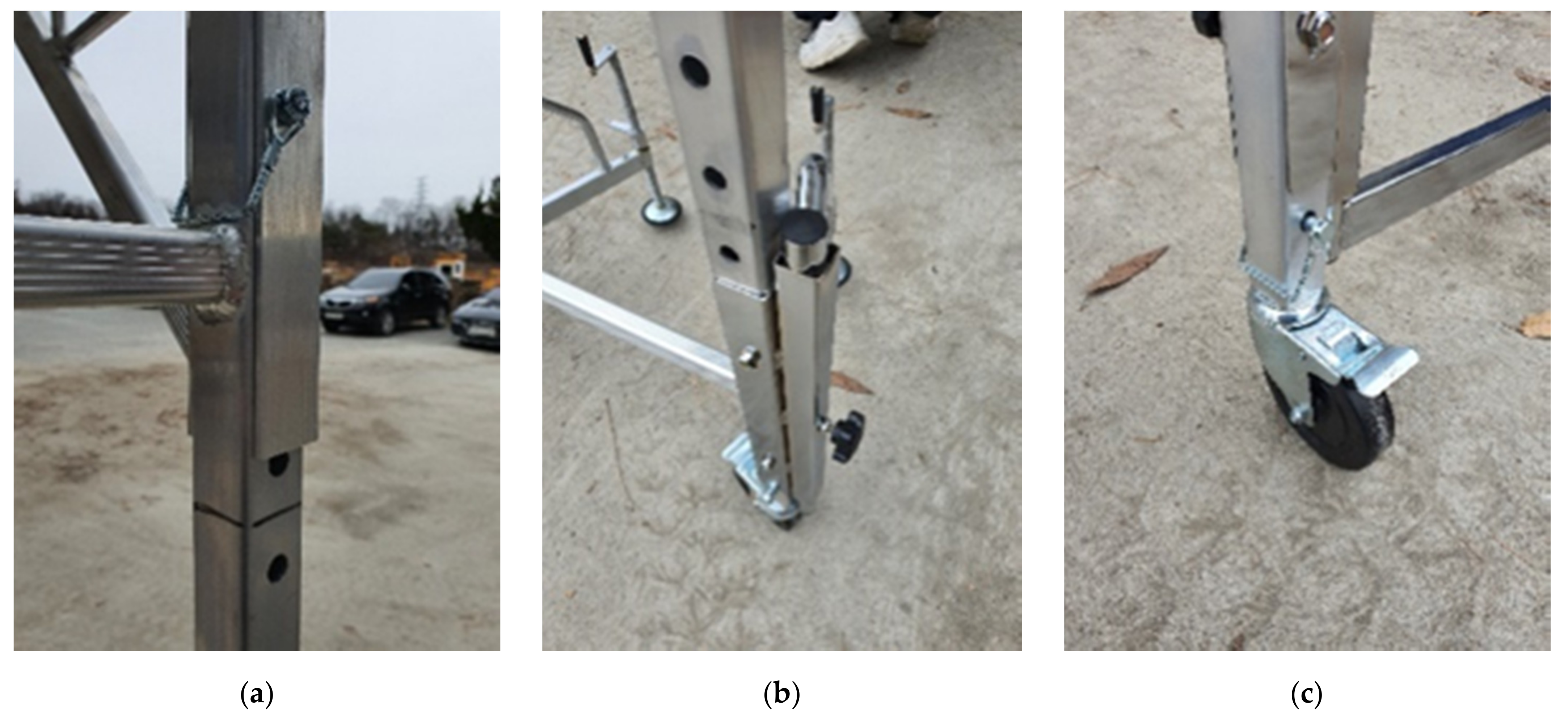

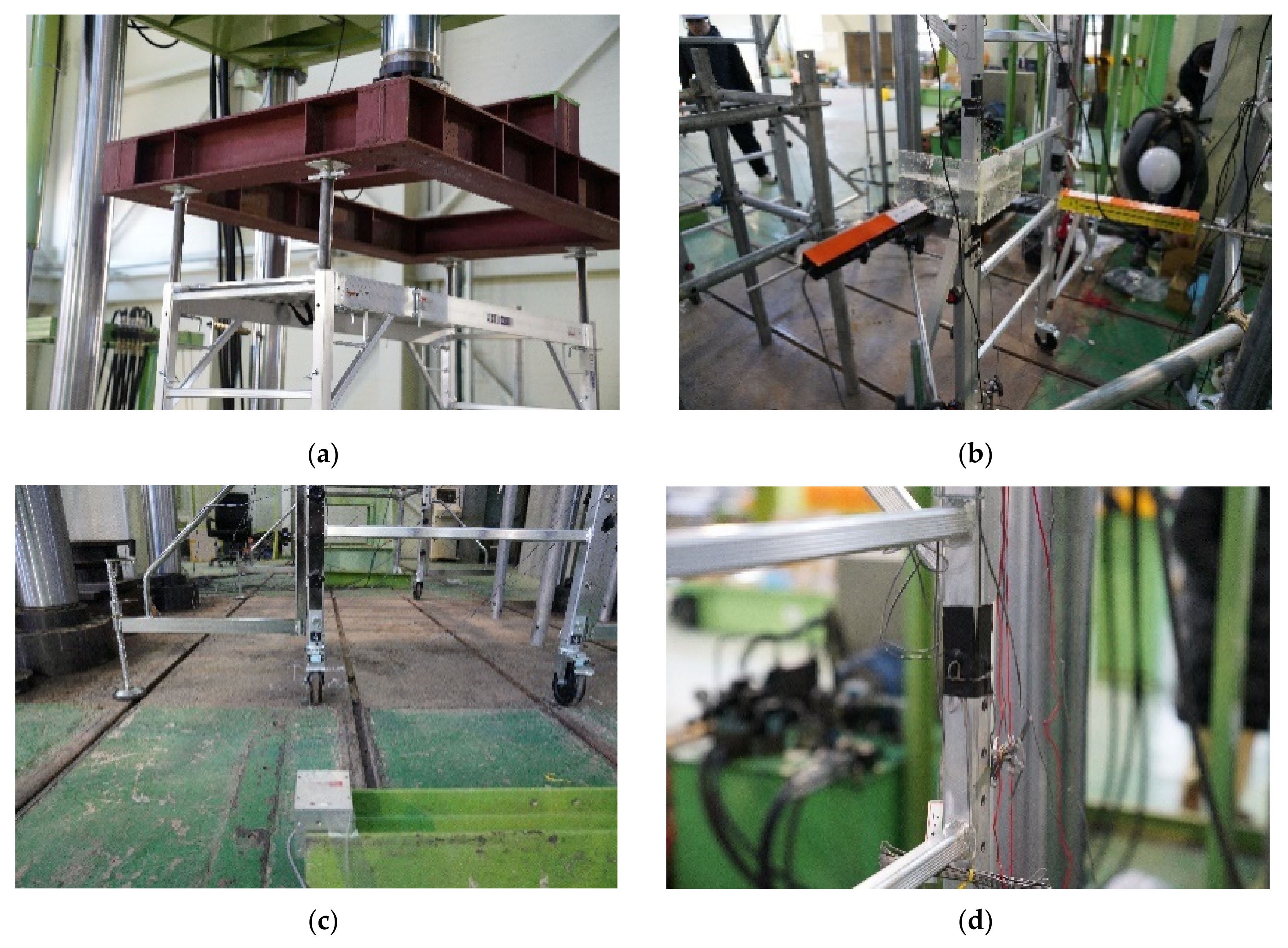



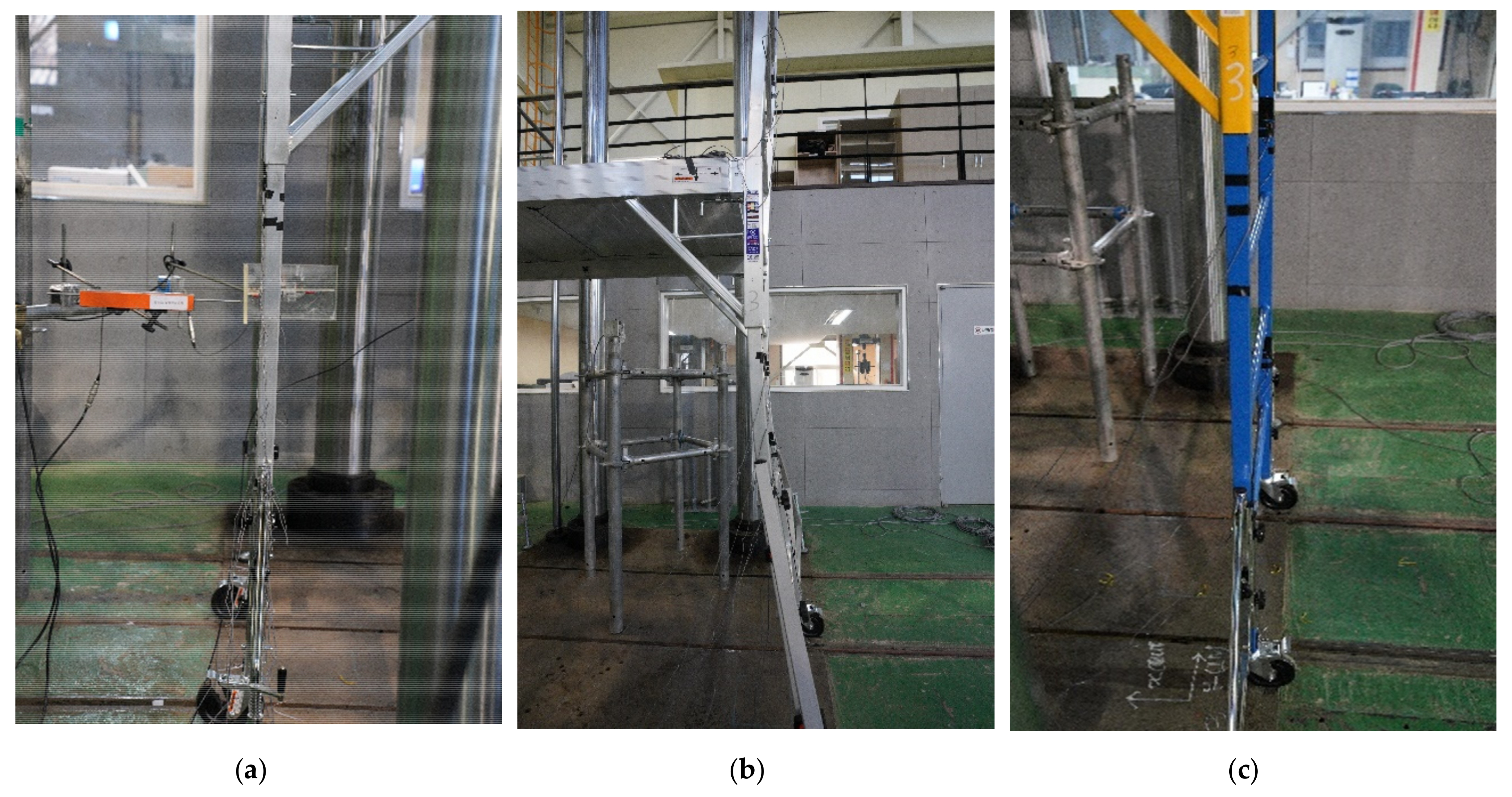
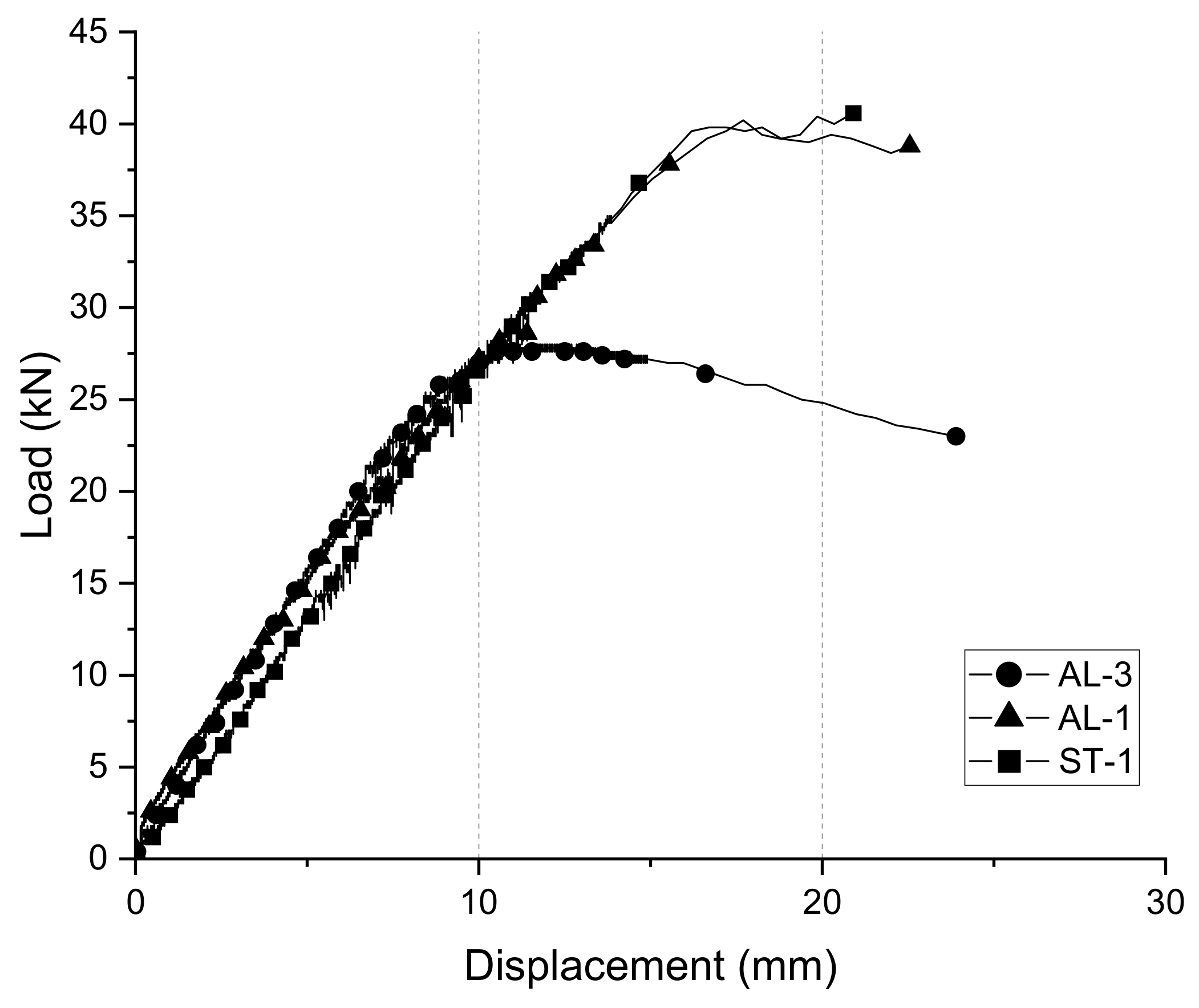




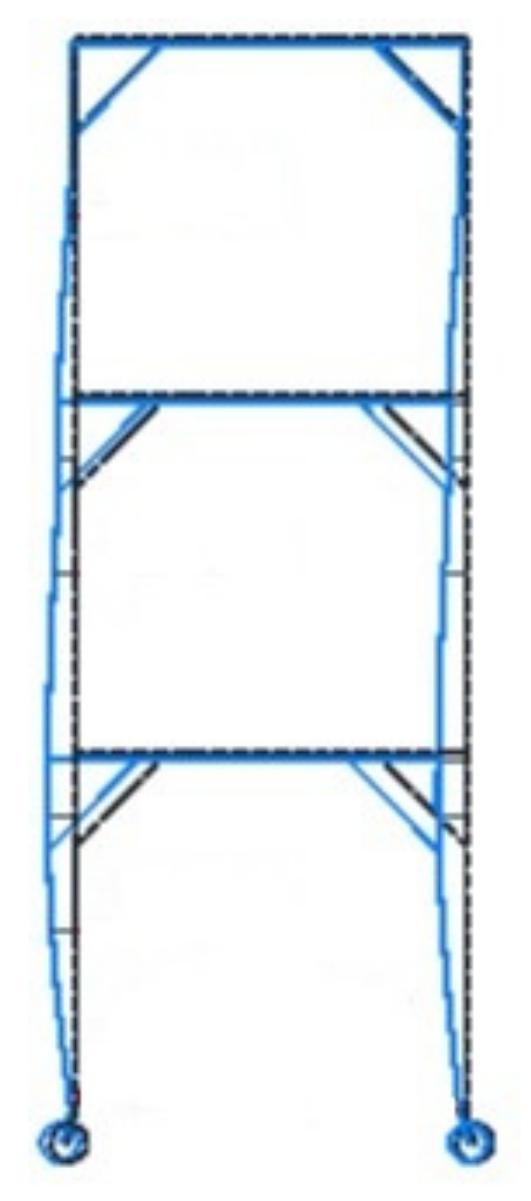
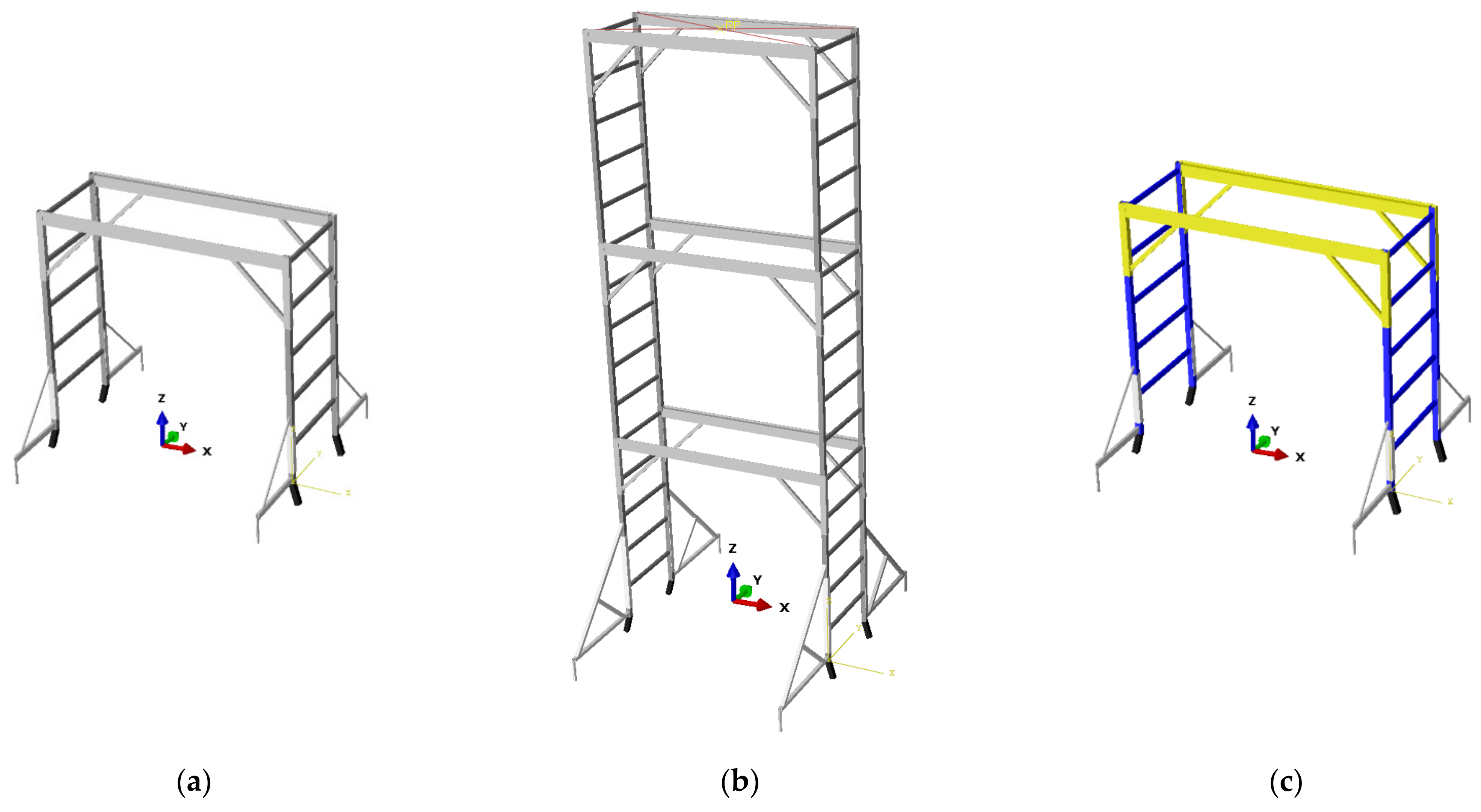


| Work Type | Vertical Load Per Unit Area |
|---|---|
| Light work where only light tools are used | 1.25 kN/m2 or more |
| Heavy work requiring construction material loading | 2.5 kN/m2 or more |
| Heavy work resources | 3.5 kN/m2 or more |
| Load Class | Uniformly Distributed Load, q |
|---|---|
| 2 | 1.5 kN/m2 |
| 3 | 2.0 kN/m2 |
| Specimen | AL-1 | AL-3 | ST-1 |
|---|---|---|---|
| Shape | 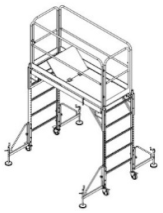 | 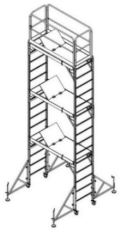 | 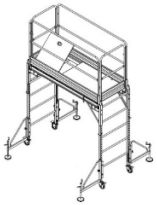 |
| Note | 1-story aluminum | 3-story aluminum | 1-story steel |
| Height | 1918 mm | 5048 mm | 1918 mm |
| Width | 1910 mm × 698 mm | 1910 mm × 698 mm | 1910 mm × 698 mm |
| Specimen | Aluminum (1-Story, 3-Story) | Steel (1-Story) | ||
|---|---|---|---|---|
| Vertical Member | Horizontal Member | Vertical Member | Horizontal Member | |
| Material | A6063 | A6063 | SS275 | SS275 |
| Yield strength (MPa) | 214 | 214 | 275 | 275 |
| Length (mm) | 1650 | 1881 | 1650 | 1878 |
| Cross-section (mm) | 39.5 × 39.4 | 100 × 32.5 | 38 × 38 | 100 × 38 |
| Thickness (mm) | 3 | 2.5 | 1.7 | 1.7 |
| Category | Caster Wheel |
|---|---|
| Wheel material | Urethane |
| Wheel diameter | Ø125 mm |
| Fixed shaft material | SS275 |
| Fixed shaft | Ø33 mm × L95 mm |
| Category | Outrigger for 1-Story Scaffold | Outrigger for 3-Story Scaffold |
|---|---|---|
| Material | SS275 | SS275 |
| Size(mm) | 480 × 490.2 | 820 × 780 |
Publisher’s Note: MDPI stays neutral with regard to jurisdictional claims in published maps and institutional affiliations. |
© 2021 by the authors. Licensee MDPI, Basel, Switzerland. This article is an open access article distributed under the terms and conditions of the Creative Commons Attribution (CC BY) license (https://creativecommons.org/licenses/by/4.0/).
Share and Cite
Kim, H.; Lim, J.; Lee, J.; Kang, Y.J.; Kim, S. Experimental Investigations on Ultimate Behavior of Fabricated Mobile Scaffolds. Metals 2021, 11, 851. https://doi.org/10.3390/met11060851
Kim H, Lim J, Lee J, Kang YJ, Kim S. Experimental Investigations on Ultimate Behavior of Fabricated Mobile Scaffolds. Metals. 2021; 11(6):851. https://doi.org/10.3390/met11060851
Chicago/Turabian StyleKim, Heesoo, Jeonghyeon Lim, Jeonghwa Lee, Young Jong Kang, and Seungjun Kim. 2021. "Experimental Investigations on Ultimate Behavior of Fabricated Mobile Scaffolds" Metals 11, no. 6: 851. https://doi.org/10.3390/met11060851
APA StyleKim, H., Lim, J., Lee, J., Kang, Y. J., & Kim, S. (2021). Experimental Investigations on Ultimate Behavior of Fabricated Mobile Scaffolds. Metals, 11(6), 851. https://doi.org/10.3390/met11060851









